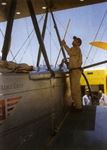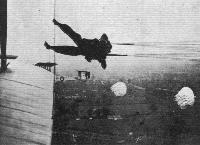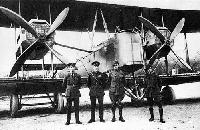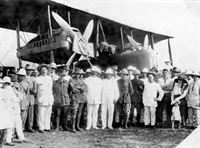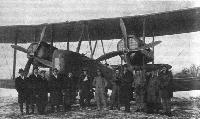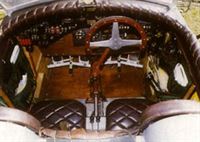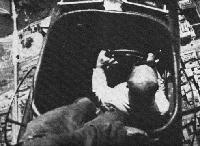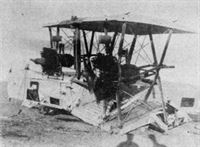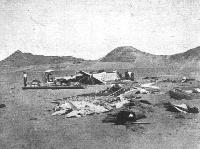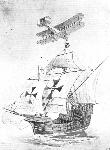
Описание
Страна : Великобритания
Год : 1917
Двухмоторный тяжелый бомбардировщик-биплан
Варианты
- Vickers - Vimy / FB.27 - 1917 - Великобритания
- Vickers - Vimy Commercial - 1919 - Великобритания
- Vickers - Vernon - 1921 - Великобритания
Vickers F.B.27 Vimy, Vimy Commercial и Vernon
Прототип бомбардировщика F.B.27 Vimy совершил первый полет 30 ноября 1917 года. Как и самолеты de Havilland DH.10 Amiens и Handley-Page V/1500, он был создан, чтобы обеспечить британским ВВС возможность наносить удары по стратегическим целям на территории Германии. Хотя небольшое количество машин каждого типа успело прибыть во Францию до заключения перемирия 11 ноября 1918 года, им не довелось принять участия в Первой мировой войне.
Крыло и оперение Vimy было выполнено по бипланной схеме, экипаж состоял из трех человек. Первый прототип Vimy был оснащен двумя 207-сильными (154 кВт) ПД Hispano-Suiza, второй - 260-сильными (194 кВт) ПД Sunbeam Maoris, третий - 300-сильными (224 кВт) Fiat A-12, а четвертый, ставший стандартом для серии, - 360-сильными (268 кВт) ПД Rolls Royce Eagle VIII.
F.B.27A Vimy Mk II был запущен в крупносерийное производство, но контракт аннулировали после завершения войны, выпустив примерно 230 машин.
Полноценная служба Vimy в ВВС началась лишь в июле 1919 года, когда ими вооружили 58-ю эскадрилью в Египте, за которой последовали другие подразделения на Ближнем Востоке и в Великобритании. Самолет оставался в строю до замены на бомбардировщик Virginia в 1924-1925 годах, хотя 502-я эскадрилья в Северной Ирландии продолжала использовать его до 1929 года.
За исключением машин из 502-й эскадрильи, около 80 Vimy с 1925 года оснастили двигателями Armstrong Siddeley Jaguar или Bristol Jupiter и передали в летные школы и для подготовки парашютистов.
Vimy оставил яркий след в истории авиации благодаря ряду рекордных перелетов. На нем Джон Алкок и Артур Уиттен Браун совершили первый в истории беспосадочный перелет через Атлантику с востока на запад, а Росс и Кейт Смит - первый перелет из Англии в Австралию. Также самолет принимал участие в первом перелете Англия - Южная Африка, осуществленном Пьером ван Раневельдом и Кристофером Брандом, лишь последний этап которого между Булавайо и Кейптауном они преодолели на DH.9.
<...>
ТАКТИКО-ТЕХНИЧЕСКИЕ ХАРАКТЕРИСТИКИ
Vickers Vimy Mk II
Тип: двухмоторный тяжелый бомбардировщик-биплан
Силовая установка: два ПД Rolls-Royce Eagle VIII мощностью по 360 л. с. (268 кВт)
Летные характеристики: макс. скорость на уровне моря 166 км/ч; потолок 2135 м; дальность полета 1448 км
Масса: пустого 3222 кг; максимальная взлетная 4937 кг
Размеры: размах крыла 20,75 м; длина 13,27 м; высота 4,76 м; площадь крыла 122,44 м2
Вооружение: по одному 7,7-мм пулемету Lewis на турели Scarff в носовой и верхней стрелковых точках и до 1123 кг бомб
- Описание
Фотографии
-
Мировая Авиация 59
Регистрационный номер: F3184 Vimy стал основным тяжелым бомбардировщиком британских ВВС в 1920-х годах, но использовался преимущественно на Ближнем Востоке в составе 45-й, 58-й, 70-й и 216-й эскадрилий и 4-й летной школы. В метрополии самолет эксплуатировали 7-я и 9-я эскадрильи и звено "D" 100-й эскадрильи.
-
Aeroplane Monthly 1994-11 / M.Stephenson - The Spirit of Brooklans
Регистрационный номер: G-EAOU [46], N71MY [39], NX71MY [39] Vickers Vimy replica N71MY over London on August 27, 1994.
Recreating the flight of the Smith brothers, Lang Kidby and Peter McMillan’s replica NX71MY is powered by a pair of 420hp (313kW) Chevrolet converted motor car engines. Flown into Mildenhall (inside a C-5 Galaxy) the Vimy was flown to Brooklands on August 27, 1994 in readiness for its appearance at the SBAC show at Farnborough. It left Farnborough on September 11 on the start of its epic flight. As AE56 closed for press, news was to hand that the Vimy had suffered a force-landing in Sumatra, thankfully with no injury to the two pilots. It was hoped to ship out a replacement engine and finish the journey. -
Aeroplane Monthly 1994-11 / M.Stephenson - The Spirit of Brooklans
Регистрационный номер: G-EAOU [46], N71MY [39], NX71MY [39] NORMAN PEALING photographed the Shell- and National Geographic-sponsored Vickers Vimy replica N71MY over the UK in August this year
-
Aeroplane Monthly 1994-11 / M.Stephenson - The Spirit of Brooklans
Регистрационный номер: G-EAOU [46], N71MY [39], NX71MY [39] -
Aeroplane Monthly 1994-11 / M.Stephenson - The Spirit of Brooklans
Регистрационный номер: G-EAOU [46], N71MY [39], NX71MY [39] Lang Kidby and Peter McMillan’s spectacular Vickers Vimy replica, used to recreate the flight of the Smith Brothers
A majestic view of N71MY over Greater London. -
Aeroplane Monthly 1994-11 / M.Stephenson - The Spirit of Brooklans
Регистрационный номер: G-EAOU [46], N71MY [39], NX71MY [39] Vickers Vimy replica N71MY over the remains of Brooklands Aerodrome, the type’s birthplace in World War One, on the day of its arrival there on August 27, 1994. The unmistakable outline of the motor-racing track round the airfield boundary is still discernible. Despite the road built across the middle of the runway (that great symbol of the airfield property developer), the Vimy managed to land there - as, incredibly, did BAC One-Eleven G-ASYD six weeks earlier when it arrived to join the Brooklands Museum, which occupies the buildings to the right of the parked airliners.
-
Aeroplane Monthly 1994-11 / M.Stephenson - The Spirit of Brooklans
Регистрационный номер: G-EAOU [46], N71MY [39], NX71MY [39] N71MY silhouetted against a Californian sunset during test-flying in the USA.
-
Aeroplane Monthly 1994-12 / M.Vines - Farnborough cameos
Регистрационный номер: G-EAOU [46], N71MY [39], NX71MY [39] The Vickers Vimy replica departed Farnborough at 1400hr on Sunday, September 11, 1994, on the first stage of its flight to Australia.
-
Aeroplane Monthly 1994-11 / M.Stephenson - The Spirit of Brooklans
Регистрационный номер: G-EAOU [46], N71MY [39], NX71MY [39] Rear three-quarter air-to-air view of Vimy N71MY. The tailwheel and the bright Shell stickers are among the very few items which visually distinguish the Chevrolet-engined modern replica from the original.
-
Aeroplane Monthly 1994-11 / M.Stephenson - The Spirit of Brooklans
Регистрационный номер: G-EAOU [46], N71MY [39], NX71MY [39] Views of the Vimy replica in the air, showing off the prominent registration lettering which led to the original being nicknamed “God ’Elp All Of Us”.
-
Aeroplane Monthly 1994-11 / M.Stephenson - The Spirit of Brooklans
Регистрационный номер: G-EAOU [46], N71MY [39], NX71MY [39] Front air-to-air view of Vimy N71MY. The tailwheel and the bright Shell stickers are among the very few items which visually distinguish the Chevrolet-engined modern replica from the original.
-
История Авиации 23 / С.Корж - Коммерческая авиация /Ретроспектива/ (9)
Регистрационный номер: G-EAOU [46], N71MY [39], NX71MY [39] Восстановленный с участием нефтяной компании "Шелл" "смитовский" "Виикерс Вими" в полете.
-
Aeroplane Monthly 1994-11 / M.Oakey - Grapevine
Регистрационный номер: G-EAOU [46], N71MY [39], NX71MY [39] Vickers Vimy replica N71MY departing from Farnborough on September 11 at the start of its commemorative flight to Australia.
-
Aeroplane Monthly 1994-11 / M.Stephenson - The Spirit of Brooklans
Регистрационный номер: G-EAOU [46], N71MY [39], NX71MY [39] N71MY on static display at Brooklands Museum in the week before Farnborough.
-
Aeroplane Monthly 1999-05 / 1999 UK Airshows & Museums Guide
Регистрационный номер: G-EAOU [46], N71MY [39], NX71MY [39] Fast and slow: North American F-86 Sabre and Vickers Vimy replica at Biggin Hill’s International Air Fair.
Другие самолёты на фотографии: North American F-86 Sabre - США - 1947
-
Aeroplane Monthly 1994-12 / M.Oakey - Grapevine
Регистрационный номер: G-EAOU [46], N71MY [39], NX71MY [39] Vickers Vimy replica NX71MY at Bahrain, en route to Australia.
-
Aeroplane Monthly 2000-01 / Millenium moments /Unforgettable events/
Регистрационный номер: G-EAOU [46], N71MY [39], NX71MY [39] Vimy replica pilots Peter McMillan (in the tan flying suit) and Lang Kidby in front of NX71MY.
-
Aeroplane Monthly 1998-10 / M.Oakey, T.Harmsworth - Vintage news
Регистрационный номер: G-EAOU [46], N71MY [39], NX71MY [39] One of the new BMW V12 engines being mounted on Vimy replica NX71MY at Kemble. Note the silver paint gradually encroaching on the NIVO green as “G-EAOU” metamorphoses into Silver Queen. The first engine was run on August 18, 1998.
-
Aeroplane Monthly 1999-06 / M.Oakey, T.Harmsworth - News
Регистрационный номер: G-EAOU [46], N71MY [39], NX71MY [39] Vimy metamorphosis: Aeroplane's November 1998 issue.
-
Aeroplane Monthly 1999-05 / 1999 UK Airshows & Museums Guide
Регистрационный номер: G-EAOU [46], N71MY [39], NX71MY [39] Vimy replica NX71MY “G-EAOU” departs Biggin Hill in 1996 with a Hunter line-up in salute.
Другие самолёты на фотографии: Hawker Hunter - Великобритания - 1951
-
Aeroplane Monthly 1999-09 / M.Oakey, T.Harmsworth - News
Регистрационный номер: N71MY [39], NX71MY [39], G-EAOU [46] Vickers Vimy replica NX71MY Silver Queen arrived at Nairobi, Kenya, on July 13, 1999, after a long delay in Djibouti.
-
Aeroplane Monthly 1999-09 / M.Oakey - Up the Nile in style /Flying in the Vimy/
Регистрационный номер: N71MY [39], NX71MY [39], G-EAOU [46] As the Vimy taxied to a halt at Luxor, a knot of people gathered on the apron to welcome it. “Are you the guys flying to South Africa?”, asked one. Yes, Mark Rebholz said, where did you hear about us? “In a magazine.” Which one?, Mark asked. The chap pointed to the logo. “Aeroplane", he said.
-
Aeroplane Monthly 1999-09 / M.Oakey - Up the Nile in style /Flying in the Vimy/
Регистрационный номер: N71MY [39], NX71MY [39], G-EAOU [46] John LaNoue dipsticks the Vimy’s fuel after arrival at Luxor.
-
Aeroplane Monthly 1999-09 / M.Oakey - Up the Nile in style /Flying in the Vimy/
Регистрационный номер: N71MY [39], NX71MY [39], G-EAOU [46] Sporting sponsors’ logos - including that of Aeroplane - the Vimy also wears a prominent “303” identification code which the Paris Air Show organisers inexplicably insisted on.
-
Aeroplane Monthly 1999-09 / M.Oakey - Up the Nile in style /Flying in the Vimy/
Регистрационный номер: N71MY [39], NX71MY [39], G-EAOU [46] In 46’C sun at Luxor, Mark Rebholz heatedly discusses landing fees with handling agents.
-
Aeroplane Monthly 1999-09 / M.Oakey - Up the Nile in style /Flying in the Vimy/
Регистрационный номер: N71MY [39], NX71MY [39], G-EAOU [46] The scene at Embaba soon after sunrise on the morning of June 26, 1999, with final preparations for the Luxor flight under way.
-
Aeroplane Monthly 1999-10
Регистрационный номер: N71MY [39], NX71MY [39], G-EAOU [46] Inbound over the Stellenbosch winelands en route to Cape Town International Airport on July 29, 1999, one large, rare, ungainly, impressive and lovable creature proclaims a message of support for another.
-
Aeroplane Monthly 1999-10 / M.Oakey, T.Harmsworth - News
Регистрационный номер: N71MY [39], NX71MY [39], G-EAOU [46] Vimy Silver Queen arrives at Cape Town on July 29, 1999.
-
Aeroplane Monthly 1999-09 / M.Oakey - Up the Nile in style /Flying in the Vimy/
Регистрационный номер: N71MY [39], NX71MY [39], G-EAOU [46] A Vimy occupant’s view of the River Nile in Egypt. Just as England-Africa route pioneers van Ryneveld and Brand would have seen it in 1920
-
Aeroplane Monthly 1999-09 / M.Oakey - Up the Nile in style /Flying in the Vimy/
Регистрационный номер: N71MY [39], NX71MY [39], G-EAOU [46] The Valley of the Kings (where the tarmac road ends), site of the tombs of Tutankhamun and many other pharaohs, slides by to starboard as the Vimy nears Luxor and the end of the flight.
-
Aeroplane Monthly 1999-09 / M.Oakey - Up the Nile in style /Flying in the Vimy/
Регистрационный номер: N71MY [39], NX71MY [39], G-EAOU [46] The Giza Plateau, with the Sphinx visible near the bottom of the picture just to the left of the black road, and Cairo’s outskirts lapping at its feet.
-
Aeroplane Monthly 1999-09 / M.Oakey - Up the Nile in style /Flying in the Vimy/
Регистрационный номер: N71MY [39], NX71MY [39], G-EAOU [46] A final view of the Pyramids, with the desert stretching away to the horizon beyond them.
-
Aeroplane Monthly 1999-09 / M.Oakey - Up the Nile in style /Flying in the Vimy/
Регистрационный номер: N71MY [39], NX71MY [39], G-EAOU [46] A magnificent view: the Giza Pyramids of Khafre (Chephren) and Khufu (Cheops) off the starboard wingtip of Vimy replica Silver Queen on the evening of June 24, 1999. The third main pyramid is just emerging from beneath the wing.
-
Aviation Historian 23
Регистрационный номер: G-AWAU [16], H651 [16] -
Мировая Авиация 45
Перелет Алкока и Брауна через Атлантику. 14-15 июня 1919г.: кэптен Джон Алкок и лейтенант Артур Уиттен Браун выполнили первый беспосадочный перелет через Атлантику на самолете Vickers Vimy, взлетев в Листерз-Филд (Ньюфаундленд) и приземлившись в Клифдене (Ирландия). Перелет занял 16 ч 27 мин, из них 15 ч 57 мин пилоты летели над водой. Самолет Vimy, оснащенный двумя моторами Rolls-Royce, был оборудован бензобаками увеличенной емкости. Летчики выиграли приз в 10000 фунтов стерлингов, учрежденный газетой "Дэйли Мэйл" еще в 1913 году. Обоих пилотов посвятили в рыцари. Сэр Джон Алкок стал старшим летчиком-испытателем фирмы "Vickers". Он погиб 18 декабря 1919 года, разбившись при выполнении полета в сложных погодных условиях в районе Руана.
-
Мировая Авиация 132
Этот снимок известен любому любителю авиации в не меньшей степени, чем фотография первого полета самолета братьев Райт. Vickers Vimy уходит в вечность - начало первого в истории перелета через Атлантику. Фотография сделана в Лестерз Филд, Ньюфаундленд.
Alcock and Brown’s Vickers Vimy leaves Newfoundland (14-15 June 1919). -
Flight 1929-06 / Flight
The Vickers "Vimy" Biplane, with two 350-h.p. Rolls-Royce engines, piloted by Capt. John Alcock, with Lieut. Arthur Whitten Brown, leaving Newfoundland on June 14, 1919.
-
Авиация и Время 2010-04 / А.Ларионов - Фарнборо-2010
Летающая копия знаменитого бомбардировщика Виккерс "Вими"
-
Aeroplane Monthly 1994-04 / 1994 UK Aircraft Collections and Museums Guide
Регистрационный номер: G-AWAU [16], H651 [16] Vickers apprentices built flying replicas of the Gunbus and Vimy, shown; both are in the Royal Air Force Museum. The Vimy, shown here at the 1969 Paris Air Show, was damaged by fire and subsequently restored as a static exhibit.
-
Aeroplane Monthly 1998-10 / M.Oakey, T.Harmsworth - Vintage news
A close-up of a new 360 h.p. BMW engine for the Vimy, replacing the old Chevrolet powerplants.
-
История Авиации 2002-03 / А.Сергиенко - Первые асы Британской Империи /Пионеры/ (3)
Регистрационный номер: B9952 F.B.27 B9952 - 1-й прототип бомбардировщика "Виккерс Вими". 30 ноября 1917г. Гордон-Белл впервые поднял этот самолет в воздух.
-
Aeroplane Monthly 1979-06 / C.Andrews - The one and only BAC Vimy
Alcock and Brown’s original aircraft.
-
Flight 1939-06 / Flight
The Vickers Vimy taking-off from Newfoundland on the attempt. The engines were two Rolls-Royce Eagles of 375 h.p.
-
История Авиации 2003-01 / С.Корж - Коммерческая авиация /Ретроспектива/ (6)
Another view of the Vimy during the take-off from Newfoundland.
-
Aeroplane Monthly 1979-06 / C.Andrews - The one and only BAC Vimy
Регистрационный номер: G-AWAU [16], H651 [16] -
Aeroplane Monthly 1979-06 / C.Andrews - The one and only BAC Vimy
Регистрационный номер: G-AWAU [16], H651 [16] G-AWAU in flight at the 1969 Paris Aero Show.
-
Мировая Авиация 59
Один из самолетов Vimy, принадлежавших 216-й эскадрилье, выполняет полет над безлюдной египетской пустыней. Хорошо различимы отдельные элементы в конструкции крыльев и шасси.
-
Flight 1920-04 / Flight
Sir Ross Smith leaving Richmond, N.S.W., on his Vickers-Vimy-Rolls.
-
Aeroplane Monthly 1999-09 / M.Oakey - Up the Nile in style /Flying in the Vimy/
A Vimy over the Great Pyramid of Pharaon Khufu (Cheops) in the 1920s.
-
Aviation Historian 1 / D.O'Connor - Flying the Furrow
A Vickers Vimy of No 216 Sqn flies over the Saladin Citadel in Cairo, Egypt. Once the airmail route had been established between Cairo and Baghdad, the Vimys of No 216 Sqn were a regular sight along the Furrow, the unit retaining biplane bombers in the Middle East until as late as 1939
-
Aviation Historian 1 / D.O'Connor - Flying the Furrow
A trio of Vimys flying in formation over the fertile fields of the Nile Delta in Egypt. In 1925 it was agreed by the RAF and Imperial Airways that the latter would take over the desert airmail service, starting in late 1926.
-
Мировая Авиация 59
Регистрационный номер: F9147 Vimy F9147 c двигателями Rolls-Royce Eagle. Машина принадлежала 9-й эскадрилье, базировавшейся в Мэнстоне и эксплуатировавшей Vimy с апреля 1924 года по июнь 1925 года.
-
История Авиации 2003-03 / С.Корж - Коммерческая авиация /Ретроспектива/ (8)
Регистрационный номер: G-EAOU [46], N71MY [39], NX71MY [39] -
Aeroplane Monthly 1979-06 / C.Andrews - The one and only BAC Vimy
Регистрационный номер: G-AWAU [16], H651 [16] -
Flight 1930-07 / Flight
Tense Moments Parachutists being pulled off. The machines are Vickers Vimys.
-
Flight 1929-06 / Flight
A DRESS REHEARSAL: A striking picture, taken from the air, of six airmen making a simultaneous parachute drop from three Vickers "Vimy" bombers, during a rehearsal of this event, at Henlow, for the forthcoming R.A.F. Display.
-
Aeroplane Monthly 1974-09 / ??? - Hendon Pageantry 1920-37
AN EXTRA TURN: An unexpected thrill was provided by three Vickers "Vimys," each of which dropped two parachutists. Our photograph shows four of the six descending.
A pair of Vickers Vimys, each dropping two parachutists, at the 1927 pageant. -
Flight 1931-07 / Flight
THEY'RE OFF! THE SIX PARACHUTES GENTLY BUT FIRMLY WITHDRAW THE SIX PARACHUTISTS FROM THE THREE VICKERS "VIMYS"
-
Flight 1930-07 / Flight
Parachute Section, Home Aircraft Depot: Six parachutists leaving the three Vimys.
-
Flight 1929-07 / Flight
TENTH R.A.F. DISPLAY. EVENT 3: PARACHUTE DESCENTS: A thrilling demonstration by the Parachute Section of the Home Aircraft Depot. Above, six airmen are seen leaving the three Vickers Vimy machines. Below, they are nearing the ground; the two on the left collided, and one released another, emergency, 'chute (which can be seen opening) and thus avoided an accident.
-
Aeroplane Monthly 1976-06 / Personal album
Регистрационный номер: F8631 Vickers F.B.27 Vimy F8631, with a pair of 360 h.p. Rolls-Royce Eagle VIII engines, in the clear-doped finish adopted after the First World War and displaying the distinctive nose skid.
-
История Авиации 2003-01 / С.Корж - Коммерческая авиация /Ретроспектива/ (6)
Модернизированный "Вими" накануне перед взлетом на аэродроме в Сент-Джонсе (Ньюфаундленд).
-
Aeroplane Monthly 1994-11 / M.Stephenson - The Spirit of Brooklans
Регистрационный номер: G-EAOU [46], F8630 [7] The original Vimy G-EAOU before its departure for Australia in November 1919.
-
Мировая Авиация 248
Предполагалось, что самолет Vimy ждет блестящая карьера в роли тяжелого бомбардировщика, но он стал известен, благодаря рекордным перелетам.
-
История Авиации 23 / С.Корж - Коммерческая авиация /Ретроспектива/ (9)
Почтовая марка, выпущенная в Австралии в ознаменовании перелета.
-
Мировая Авиация 45
12 ноября - 15 декабря 1919г.: австралийцы братья кэптен Росс Смит и лейтенант Кейт Смит вылетели из Хоунслоу на самолете Vickers Vimy и завершили перелет 18 декабря в Дарвине, Австралия. Братья Смит первыми выполнили перелет из Англии в Австралию, покрыв расстояние в 18 170 км.
-
Air International 2020-01 / L.Jones - 'Longreach' for the Skies /Commercial/
Регистрационный номер: G-EAOU [46], F8630 [7] The first aircraft to fly between the UK and Australia - Vickers Vimy G-EAOU (c/n F8630) - departed Hounslow Heath on November 12, 1919, arriving in Darwin, Australia, 28 days later. It is now preserved at Adelaide Airport, close to where pilots Sirs Ross and Keith MacPherson-Smith were born.
-
Flight 1929-12 / Flight Advertisements
"THE VICKERS VIMY." The crew comprised Capt. Ross Smith, M.C., D.F.C., Lieut. Keith Smith, Sergt. J. W. Bennett, M.S.M., and Sergt. W. H. Shiers.
-
Flight 1940-02 / Flight
Регистрационный номер: G-UABA [5] LONDON-CAIRO-CAPE TOWN AIR-WAY: Lieut.-Col. P. Van Ryneveld, D.S.O., M.C., and Capt. C.J.Q. Brand, D.S.O., M.C., D.F.C., the Pilots and "the Crew" of the Vickers-Vimy-Rolls aeroplane "Silver Queen," on which they started from Brooklands last week to fly to Cape Town in connection with the Union of South Africa Government flight. The "Silver Queen," partly seen in the photo, is a replica of Capt. Sir Ross Smith's machine, on which he successfully accomplished the London-Australia flight
-
Air Enthusiast 2006-03 / C.Curry - Another Alcock Album /Pioneering day/
John Alcock stowing away his thermos flask of coffee ready for the transatlantic flight attempt on June 14, 1919. Brown can he seen passing up the chocolate and other provisions.
-
Air Enthusiast 1994-12 / J.Grant - First to 'OZ'
The Vimy and its crew, Wally Shiers in front, the Smith brothers and James Bennett at the rear.
-
Мировая Авиация 73
Регистрационный номер: G-UABA [5] Южноафриканские пионеры. 4 февраля 1920г.: к выполнению третьего перелета на самолете Vickers Vimy приступили Пьер ван Райнфельд и Кристофер Квинтин Брэнд, взлетевшие на "Silver Queen" из Бруклендса. Машина G-UABA выполнила вынужденную посадку в Коросо, местечке между Каиром и Хартумом. Перелет до Кейптауна был продолжен на самолете DH.9.
-
Air Enthusiast 1995-09 / J.Godwin - Wings to the Cape
Регистрационный номер: G-UABA [5] The Silver Queen on the compass turntable at Brooklands.
-
Air Pictorial 1999-07
Регистрационный номер: N71MY [39], NX71MY [39], G-EAOU [46] Silver Queen, the replica Vickers Vimy, left Brooklands on June 2, 1999, for the short hop to Farnborough, where, the following day, the crew received cheques totalling ?15,000 from British Aerospace and TAG Aviation. The companies are supporting the aircraft’s re-enactment of the first flight from Europe to South Africa in 1920 by Lt Col Pierre Van Ryneveld and Flt Lt Quintin Brand. The replica, piloted by Mark Rebholz and John LaNoue, seen left in the cockpit, with, standing, the two educationalists who will travel with the aircraft, later left Farnborough for Munich from whence it will appear at the Paris Air Show before flying to Cape Town.
-
Air Pictorial 1999-07
Регистрационный номер: N71MY [39], NX71MY [39], G-EAOU [46] -
Flight 1920-03 / Flight
A call at Singapore en route to Australia: A snapshot of Sir Ross Smith's Vickers-Vimy-Rolls, secured by Mr. Thomas Sibary, of the Dunlop Rubber Co. (Far East), Ltd., which has been sent to us by Mr. Alex-Mosses, of radiator fame
-
Flight 1920-04 / Flight
Регистрационный номер: G-EAOU [46], F8630 [7] Sir Ross Smith at Richmond, N.S.W., getting ready
-
Aeroplane Monthly 1994-11 / M.Stephenson - The Spirit of Brooklans
Регистрационный номер: G-EAOU [46], F8630 [7] Hot and dry: G-EAOU at Anthony’s Lagoon, Queensland, Australia, in December 1919 after its pioneering flight from England. En route the Vimy and its crew had endured severe turbulence, low cloud, torrential rain, a gale which nearly flipped the aircraft over on the ground, birdstrikes, boggy landing grounds, close encounters with trees and mountains, and fog.
-
Flight 1940-09 / Flight
Considerable numbers of the Vickers Vimy, of the type which crossed the Atlantic in 1919, were built by Westlands.
-
Flight 1940-05 / Flight
Two big ones, the Vickers Vimy of 1918 (shown) next the Handley Page O/400 which was to bomb Berlin.
-
Flight 1937-05 / Flight
FIRST ATLANTIC FLIGHT: THE VICKERS "VIMY" WAS USED BY ALCOCK AND BROWN IN FLIGHT ACROSS ATLANTIC IN 1919.
The Vickers Vimy with Rolls-Royce Eagle engines was the first aeroplane type to cross the Atlantic, to fly from England to S. Africa, and from England to Australia. All these flights were made in 1919. -
Flight 1927-03 / Flight
Vickers "Vimy" (Two Rolls-Royce "Eagles"). The Vickers "Vimy" is another of the Service Veterans which must surely be approaching; the end of its long career of good work with the R.A.F. The original "Vimy" was produced in 1917, after which several models made their appearance, each an improvement on the other. The end of the Great War came, however, before the "Vimy" could carry out a series of big raids into the enemy country, as planned and show what it could do. However, after the Armistice it was put into production for service with bombing squadrons. At present only No. 502 Special Reserve Squadron (Aldergrove) has "Vimys."
-
Air Enthusiast 1995-09 / J.Godwin - Wings to the Cape
Регистрационный номер: G-UABA [5] Natives haul the Silver Queen out of the mud at Livingstone.
-
Air Enthusiast 1992-12 / J.Grant - First Across
Регистрационный номер: G-EAOU [46], F8630 [7] Vickers Vimy G-EAOU (God 'Elp All Of Us!), the first aircraft to achieve the UK-Australia flight, piloted by Ross and Keith Smith, shown moments after landing at Darwin on December 10, 1919.
-
Air Pictorial 1955-06 / The journal of a roving spotter
This Vickers Vimy was on the strength of No. 4 F.T.S. at Abu Sueir, Egypt, in 1930. The usual Rolls-Royce Eagles had been replaced by Armstrong-Siddeley Jaguars. This photograph of the Jaguar-Vimy comes from the scrapbook of Air Vice-Marshal the Earl of Bandon, Assistant Chief of Air Staff (Training). He was then Visiting No. 2 F.T.S. while on the staff of the Central Flying School.
-
Aeroplane Monthly 1979-06 / C.Andrews - The one and only BAC Vimy
Регистрационный номер: G-AWAU [16], H651 [16] -
Aeroplane Monthly 1979-06 / C.Andrews - The one and only BAC Vimy
Регистрационный номер: G-AWAU [16], H651 [16] The transatlantic Vimy originally had a wheel in place of the normal nose skid, but this was removed before the flight. The view here can be compared with the shot of Alcock and Brown’s original aircraft,
-
Aeroplane Monthly 1986-01 / 1986 UK Aircraft Collections and Museums Guide
Регистрационный номер: H651 [16], G-AWAU [16] Vickers Vimy replica painted as H651.
-
Air-Britain Aeromilitaria 1983-04
Регистрационный номер: F9181 Vimy F9181 attached to No.56 Squadron, Biggin Hill, 1923
-
Air-Britain Aeromilitaria 1982-04
The Vickers Versailles, first across the Atlantic non-stop. But would the RAF clerks be able to spell it?
-
Aeroplane Monthly 1994-11 / M.Stephenson - The Spirit of Brooklans
Регистрационный номер: G-EAOU [46], F8630 [7] Cold and wet: the original Vimy departing from Hounslow on the bleak and snowy morning of November 12, 1919. The temperatures on the first leg to Lyons were so cold that the crew’s sandwiches froze solid.
-
Flight 1929-07 / Flight
Регистрационный номер: F9569 VICKERS "VIMY": Training Bomber, with two Napier "Lions" (other engines also fitted).
-
Aeroplane Monthly 1988-05 / Personal album. Military
Регистрационный номер: F9183 Vickers Vimy F9183. This 68ft 1in-span heavy bomber was powered by two Rolls-Royce Eagle VIII engines; it entered service in numbers early in 1919, and was superseded by the Vickers Virginia in 1924-25.
-
Jane's All the World Aircraft 1980 / Encyclopedia of Aviation - 1. Chronology
Vickers Vimy of No 216 Squadron RAF, operating the pioneer Cairo-to-Baghdad airmail service, which ended in August 1926.
-
Air Enthusiast 2006-03 / C.Curry - Another Alcock Album /Pioneering day/
The Vimy crated lip and transported by horse and trailer to the field at Quidi-Vidi, St John's, Newfoundland. This was the field chosen by the Martinsyde crew. When the 'Raymor' crashed, Raynham kindly offered the field for the Vimy team to share while the Martinsyde crew tried to rebuild their damaged aeroplane.
-
Aeroplane Monthly 1994-05 / R.Willson - Early days at Vickers
Alcock and Brown’s transatlantic Vimy being erected at Quidi Vidi airfield, Newfoundland, shortly before their epic flight of June 14-15, 1919.
-
Aeroplane Monthly 1982-10 / B.Gunston - The classic aero engines (2)
Two 360 h.p. Eagle VIIIs were installed in Alcock and Brown's Vickers Vimy.
-
Air Enthusiast 2006-03 / C.Curry - Another Alcock Album /Pioneering day/
The Vimy production line at Brooklands in April 1919 with Vimy fuselage No.13 at the far right. This example was chosen to he modified for the transatlantic attempt. The shop manager strung up some little flags above the Vimy to mark the occasion.
-
Aeroplane Monthly 1979-06 / C.Andrews - The one and only BAC Vimy
Регистрационный номер: G-AWAU [16], H651 [16] The replica's immaculate cockpit, complete with Edwardian engine switches.
-
Aeroplane Monthly 1993-12 / B.Robertson - An AID to quality (2)
The right-hand-drive cockpit of a Vickers Vimy was functional and ugly, with few “dials” - the engine instruments were on the inboard sides of the nacelles.
Control cables were checked for strength as well as for correct operation, and were tagged as evidence of inspection. -
Aeroplane Monthly 1999-09 / M.Oakey - Up the Nile in style /Flying in the Vimy/
Регистрационный номер: N71MY [39], NX71MY [39], G-EAOU [46] The Vimy’s cockpit. The control wheel can be used by either pilot.
-
Air Enthusiast 1972-06 / L.Coombs - Front-office evolution (2)
In the Vickers Vimy, the pilot was seated on the right, following common practice in British aircraft of the day. The large diameter of the control wheel is obvious.
-
Aeroplane Monthly 1999-09 / M.Oakey - Up the Nile in style /Flying in the Vimy/
Регистрационный номер: N71MY [39], NX71MY [39], G-EAOU [46] Vimy pilots Mark Rebholz (left) and John LaNoue, both fully occupied at 5,500ft over the Nile. Project photographer Pete McBride is in the aft cockpit. Note the sharp demarcation between desert and cultivated land in the background.
-
Aeroplane Monthly 1979-10 / Personal album
Регистрационный номер: J7448 [2] A series of views from the mid-upper gunner’s position in Vickers Vimy J7448. Top, looking forward to the cockpit; Bottom, looking back between the biplane tail and twin fins and rudders;
-
Aeroplane Monthly 1979-10 / Personal album
Регистрационный номер: J7448 [2] A view from the mid-upper gunner’s position in Vickers Vimy J7448, looking out along the port wings past one of the 360 h.p. Rolls-Royce Eagle VIII engines. Entering service with the RAF at the end of the First World War, the Vimy was not used operationally in that conflict, but served faithfully until as late as 1929. This particular Vimy belonged to No 4 Flying Training School based at Abu Sueir, Egypt, and all of these pictures were probably taken in the Middle East.
-
Aviation Historian 28 / M.Russell - Bring Out the Big Guns
Регистрационный номер: F9146 In 1917 Vickers Vimy F9146 was fitted with a trunnion-mounted 37mm COW gun in a modified nose section at Brooklands. The Vimy was used in trials with the gun for possible use as a Home Defence machine to counter airships and bombers, but the gun’s length and recoil made it cumbersome and the idea was not adopted.
-
Aeroplane Monthly 1999-09 / M.Oakey - Up the Nile in style /Flying in the Vimy/
Регистрационный номер: N71MY [39], NX71MY [39], G-EAOU [46] Equipped for the trip: the nose cockpit, complete with Editor’s feet, loaded up for the Cairo-Luxor flight.
-
Aeroplane Monthly 1999-09 / M.Oakey - Up the Nile in style /Flying in the Vimy/
Регистрационный номер: N71MY [39], NX71MY [39], G-EAOU [46] The view from the bay window: the Vimy’s nose cockpit provides a memorable vantage point a few thousand feet above the Nile.
-
Aeroplane Monthly 1979-06 / C.Andrews - The one and only BAC Vimy
Регистрационный номер: G-AWAU [16], H651 [16] The fuselage structure.
-
Aeroplane Monthly 1979-06 / C.Andrews - The one and only BAC Vimy
Регистрационный номер: G-AWAU [16], H651 [16] An uncovered outer wing panel.
-
Aeroplane Monthly 1979-06 / C.Andrews - The one and only BAC Vimy
Регистрационный номер: G-AWAU [16], H651 [16] The completed port upper outer wing panel at Weybridge.
-
Aeroplane Monthly 1993-11 / M.Oakey - Grapevine
Wayne Daley of Brisbane-based Aircraft Engineering holds a fin and rudder of Peter McMillan and Lang Kidby’s Vickers Vimy reproduction.
-
Aeroplane Monthly 1979-06 / C.Andrews - The one and only BAC Vimy
Регистрационный номер: G-AWAU [16], H651 [16] The assembled tail surfaces.
-
Aeroplane Monthly 1979-06 / C.Andrews - The one and only BAC Vimy
Регистрационный номер: G-AWAU [16], H651 [16] The seventh of eight propeller laminations is glued up before being clamped into the jig in the foreground. Each lamination was made from inch-thick mahogany.
-
История Авиации 2003-01 / С.Корж - Коммерческая авиация /Ретроспектива/ (6)
В таком положении завершился исторический перелет через Атлантику Элкока и Брауна.
-
Мировая Авиация 59
Элкок и Браун у скапотировавшего при посадке в Клифдене, Ирландия, самолета Vimy. Площадку для посадки выбрал Элкок, но болото на месте лужайки он разглядел слишком поздно.
-
Air Enthusiast 2006-03 / C.Curry - Another Alcock Album /Pioneering day/
A large tent was still not large enough to act as a hangar for the Vimy, which had to he totally reassembled out in the open air.
-
Air Enthusiast 2006-03 / C.Curry - Another Alcock Album /Pioneering day/
The weather was so bad that special screens were erected to keep the wind and rain off the mechanics and riggers as they reassembled the Vimy.
-
Aeroplane Monthly 1979-10 / Personal album
Ack-emmas and local natives examine an anonymous but already rebuilt Vimy, JR?42?, bent by CpI Gordon, place and date unknown.
-
Aeroplane Monthly 1979-06 / C.Andrews - The one and only BAC Vimy
Регистрационный номер: H651 [16], G-AWAU [16] Disaster strikes at Ringway, Manchester, on July 14, 1969. In the picture on the top the fire can be seen starting on the leading edge of the port lower main-plane, just behind the second strut from the tip. The next view shows the wing well alight, and the fire spreading outwards and upwards.
-
Aeroplane Monthly 1979-06 / C.Andrews - The one and only BAC Vimy
Регистрационный номер: H651 [16], G-AWAU [16] The port upper wing structure still burning. Note that the aircraft had been given military markings by this time.
-
Aeroplane Monthly 1979-10 / Personal album
Регистрационный номер: F8632 [2] Vickers-built Vimy F8632 after "P/O Robertson's crash" - unfortunately undated. Picture shows it immediately after the mishap.
-
Aeroplane Monthly 1979-10 / Personal album
Регистрационный номер: F8632 [2] Vickers-built Vimy F8632 after "P/O Robertson's crash" - unfortunately undated. Picture depicts it during recovery, with its outer wing panels removed. This Vimy has been re-engined with Armstrong Siddeley Jaguar aircooled radial engines, as were quite a few after withdrawal from first-line service.
-
Flight 1920-03 / Flight
Регистрационный номер: G-UABA [5] CAIRO-CAPE AIR-WAY: The crash of the first "Silver Queen." A general view of the wreckage at Korosko.
-
Air Enthusiast 1995-09 / J.Godwin - Wings to the Cape
The crash of Silver Queen II at Bulawayo.
-
Aeroplane Monthly 1994-11 / M.Stephenson - The Spirit of Brooklans
Регистрационный номер: G-EAOU [46], F8630 [7] -
Flight 1925-06 / Flight
TWO ATLANTIC CROSSINGS: Six years ago, on Sunday next, a Vickers' "Vimy" with two Rolls-Royce engines, piloted by the late Sir John Alcock, and navigated by Sir A. Whitten Brown, left Newfoundland on its flight across the Atlantic, landing 16 hours 12 mins. later at Clifden, Co. Galway, Ireland, thus completing the first non-stop flight across the Atlantic. Columbus's ship "Santa Maria," left the Canary Islands on September 6, 1492, and made a landfall at what is now known as Watling Island, in the Bahama group, on October 12. The object of the above illustration is to show the comparative sizes of the craft, and it might be pointed out that the drawing was made over a photograph of two models made to the same scale and photographed in position in the vertical plane, so that even taking into account the effect of perspective a correct idea of relative sizes is obtained.
-
Aeroplane Monthly 1999-12 / E.Morgan - Vickers' big 'boat /Type history/
A Vickers proposal for a “Vimy Boat Seaplane” amphibian conversion of the Vimy bomber; drawing No 5156, dated April 30, 1920. The design mated Vimy flying surfaces with a new hull.
Тип фотографий
- Все фото (130)
- Боковые проекции (1)
- Цветные фото (39)
- Ч/б фото (59)
- Кабина (10)
- Реставрация (6)
- Обломки (11)
- Рисунки, схемы (4)






















